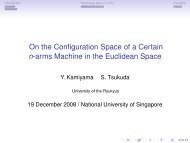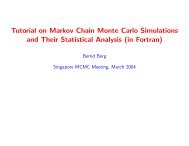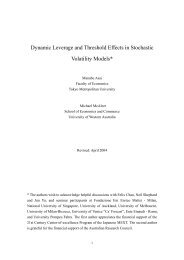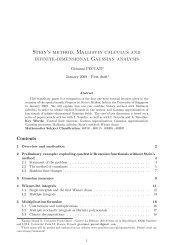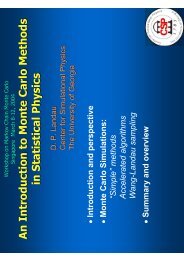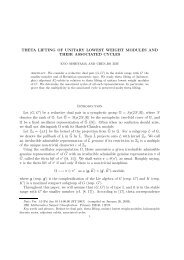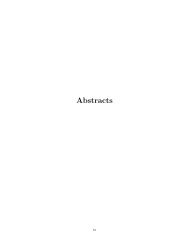PDF 2
PDF 2
PDF 2
You also want an ePaper? Increase the reach of your titles
YUMPU automatically turns print PDFs into web optimized ePapers that Google loves.
RNA secondary structure<br />
prediction methods<br />
• Covariation using mutual information<br />
– requires reliable multiple sequence/structure<br />
alignment of many RNAs<br />
• Stochastic context free grammars (generalization<br />
of HMMs)<br />
• Energy minimization methods<br />
FOCUS of talk on energy minimization, but first<br />
briefly mention other two methods.<br />
Peter Clote<br />
July 2007
Stochastic context free grammars<br />
Context free grammar for<br />
L= {well-balanced parenthesis<br />
expressions}<br />
consists of rules<br />
S λ | (S) | SS<br />
Key notions:<br />
λ is empty word<br />
Terminal symbols: ‘(‘, ‘)’<br />
Variables: S<br />
Peter Clote<br />
July 2007
Derivation<br />
S (S) (SS) ((S)S) (( )S)<br />
(( )(S)) (( )( ))<br />
Leftmost derivation (apply rule to leftmost<br />
occurring variable in each step)<br />
One-one association between leftmost<br />
derivations and parse trees<br />
Peter Clote<br />
July 2007
Context free grammar for RNA<br />
consists of following rules (here,<br />
balanced parentheses correspond to<br />
Watson-Crick or GU base pairs).<br />
S λ | AS | CS | GS | US | ASU |<br />
USA | CSG | GSC | GSU | USG |<br />
SS<br />
Peter Clote<br />
July 2007
• Branching given by rule S SS<br />
• Watson-Crick base pairings given by rules<br />
S ASU | GSC | etc.<br />
• Unpaired bases (e.g. in hairpin loop) given<br />
by rules<br />
S AS | GS | etc.<br />
• Stochastic grammar has probabilities<br />
associated with rule applications<br />
Peter Clote<br />
July 2007
http://www.genetics.wustl.edu/eddy/tRNAscan-SE/<br />
Peter Clote<br />
July 2007
Secondary structure<br />
ACGUACGUACGU<br />
((((....))))<br />
RNA secondary structure is an<br />
outerplanar graph, or equivalently, a<br />
balanced parenthesis expression (only<br />
one kind of parenthesis).<br />
Peter Clote<br />
July 2007
Secondary structure definition<br />
Peter Clote<br />
July 2007
Peter Clote<br />
July 2007
Ding and Lawrence, A statistical sampling algorithm for {RNA} secondary structure<br />
prediction, Nucleic Acids Res., 31(24):7280--7301 (2003)<br />
Peter Clote<br />
July 2007
Type H pseudoknot, taken from Dirks, Pierce, “A partition function<br />
algorithm for nucleic acid secondary structure including pseudoknots<br />
J Comput Chem, 24(13):1664-1677, 2003<br />
Peter Clote<br />
July 2007
PSEUDOBASE collection of classified pseudoknots<br />
http://wwwbio.leidenuniv.nl/~batenburg/pkb.html<br />
Peter Clote<br />
July 2007
Example of pseudoknot causing frameshift, taken from<br />
Von Batenburg’s PSEUDOBASE<br />
http://wwwbio.leidenuniv.nl/~batenburg/PKBase/PKB00240.html<br />
Peter Clote<br />
July 2007
Counting number of<br />
secondary structures<br />
Peter Clote<br />
July 2007
Counting number of secondary<br />
structures<br />
• Secondary structures are balanced parenthesis<br />
expressions with dots<br />
• Catalan numbers give the number of balanced<br />
parenthesis expressions (without dots)<br />
Peter Clote<br />
July 2007
Catalan number c(n-1) is the number of<br />
balanced parenthesis expressions of length n.<br />
Initial Goal: Count number of secondary<br />
structures (Motzkin numbers)<br />
Peter Clote<br />
July 2007
Case 1: n+1 not base paired<br />
Case 2: n+1 base paired with intermediate j<br />
Peter Clote<br />
July 2007
Peter Clote<br />
July 2007
General treatment of cases<br />
Case 1: n+1 not base paired<br />
Case 2: n+1 base paired with i<br />
Case 3: n+1 base paired with intermediate j<br />
Peter Clote<br />
July 2007
Peter Clote<br />
July 2007
Peter Clote<br />
July 2007
Peter Clote<br />
July 2007
Peter Clote<br />
July 2007
Peter Clote<br />
July 2007
Asymptotics for Motzkin numbers<br />
• Is there a closed formula for the asymptotic<br />
number S(n) of secondary structures, where any<br />
base can pair with any base, and where the<br />
threshold for hairpin loops is 1?<br />
• Two methods of solution:<br />
– Viennot, Vauchaussade de Chaumont, “Enumeration<br />
of RNA secondary structures by complexity”, Lecture<br />
Notes in Biomaths. 57 (1985) 360-365. Uses generating<br />
functions and influenced Nebel’s later work.<br />
– Stein, Waterman: applied Bender’s theorem<br />
Peter Clote<br />
July 2007
Peter Clote<br />
July 2007
Peter Clote<br />
July 2007
Peter Clote<br />
July 2007
Peter Clote<br />
July 2007
Bender’s theorem for asymptotics<br />
Peter Clote<br />
July 2007
Peter Clote<br />
July 2007
Peter Clote<br />
July 2007
Peter Clote<br />
July 2007
Peter Clote<br />
July 2007
Peter Clote<br />
July 2007
Peter Clote<br />
July 2007
• Asymptotic (exponential) formula for the number<br />
S(n) of secondary structures is STARTING<br />
POINT for NEUTRAL NETWORKS (Schuster,<br />
Fontana, Stadler, Hofacker, et al.)<br />
Sequence Space {A,C,G,U} n<br />
(Genotype)<br />
Shape Space {‘(‘,’)’,’.’} n<br />
(Phenotype)<br />
Peter Clote<br />
July 2007
• What is the number of secondary structures for a<br />
given RNA nucleotide sequence, where base pairs<br />
are either Watson-Crick or GU wobble pairs, and<br />
hairpin loops have at least 3 (or more generally θ)<br />
unpaired bases?<br />
Peter Clote<br />
July 2007
From combinatorics to<br />
secondary structure energy<br />
minimization algorithms<br />
Peter Clote<br />
July 2007
Key idea<br />
• Absence of pseudoknots in secondary structures<br />
allows determination of optimal secondary<br />
structure for s i ,…,s j to be made independently of<br />
s k ,…,s l whenever i
• Pascal’s triangle is a dynamic programming<br />
computation of binomial coefficients:<br />
C(n,k) = C(n-1,k)+C(n-1,k-1)<br />
1<br />
11<br />
121<br />
1331<br />
14641<br />
Peter Clote<br />
July 2007
Idea of Nussinov-Jacobson: add the contribution<br />
due to each base pair, ignoring stabilizing energies for<br />
stacked base pairs or destabilizing energies of loops<br />
(unpaired) regions.<br />
Peter Clote<br />
July 2007
• M i,j equals the maximum number of base pairs in<br />
s i ,…,s j<br />
• M j,i equals index r such that if r,j base pair then<br />
maximum number of base pairs is realized in<br />
s i ,…,s j<br />
• M j,i used for linear time traceback<br />
Peter Clote<br />
July 2007
Peter Clote<br />
July 2007
Peter Clote<br />
July 2007
Peter Clote<br />
July 2007
Dynamic programming order of filling in matrix:<br />
left to right along principal diagonal, then successively<br />
fill off-diagonals proceeding outwards.<br />
Peter Clote<br />
July 2007
Compute energy matrix M<br />
Cubic time FILL algorithm<br />
Upper triangular part of M contains energies<br />
Lower triangular part of M contains crumbs<br />
for traceback
acktrack(i,j)<br />
Linear time backtracking algorithm<br />
after the energy matrix is filled
Zuker-Stiegler modification of<br />
Nussinov-Jacobson<br />
1) An isolated base pair contributes no energy by itself;<br />
instead consider experimentally measured stacking<br />
energies<br />
5’-XA-3’<br />
3’-YB-5’<br />
2) Consider experimentally measured loop energies for<br />
hairpin,bulge and internal loops (not multiloops).<br />
3) Affine approximation for multiloop energy<br />
a+bI+cU<br />
for I internal base pairs and U unpaired bases in multiloop<br />
having external pair (i,j), i.e. within i+1,…,j-1.<br />
Peter Clote<br />
July 2007
mfold base stacking energies at 37<br />
degrees Celsius<br />
Peter Clote<br />
July 2007
Nearest neighbor model (stacked<br />
base pairs)<br />
See “Thermodynamic parameters for an expanded nearest-neighbor model for<br />
Formation of RNA duplexes with Watson-Crick base pairs”, Xia et al.<br />
Biochemistry 37:14719-14735 (1998)<br />
Peter Clote<br />
July 2007
See “Thermodynamic parameters for an expanded nearest-neighbor model for<br />
Formation of RNA duplexes with Watson-Crick base pairs”, Xia et al.<br />
Biochemistry 37:14719-14735 (1998)<br />
Peter Clote<br />
July 2007
See “Thermodynamic parameters for an expanded nearest-neighbor model for<br />
Formation of RNA duplexes with Watson-Crick base pairs”, Xia et al.<br />
Biochemistry 37:14719-14735 (1998)<br />
Peter Clote<br />
July 2007
Loop energies from Vienna RNA<br />
package v1.4<br />
PUBLIC int hairpin37[31] = {<br />
INF, INF, INF, 570, 560, 560, 540, 590, 560, 640, 650,<br />
660, 670, 678, 686, 694, 701, 707, 713, 719, 725,<br />
730, 735, 740, 744, 749, 753, 757, 761, 765, 769};<br />
PUBLIC int bulge37[31] = {<br />
INF, 380, 280, 320, 360, 400, 440, 459, 470, 480, 490,<br />
500, 510, 519, 527, 534, 541, 548, 554, 560, 565,<br />
571, 576, 580, 585, 589, 594, 598, 602, 605, 609};<br />
PUBLIC int internal_loop37[31] = {<br />
INF, INF, 410, 510, 170, 180, 200, 220, 230, 240, 250,<br />
260, 270, 278, 286, 294, 301, 307, 313, 319, 325,<br />
330, 335, 340, 345, 349, 353, 357, 361, 365, 369};<br />
Peter Clote<br />
July 2007
Classify loops by number of base pairs visible from<br />
Closing pair (i,j).<br />
Hairpin loop: 0-loop<br />
Peter Clote<br />
July 2007
Helix (stacked base pairs),<br />
Bulge, interior loop: 1-loops<br />
Peter Clote<br />
July 2007
Ding and Lawrence, A statistical sampling algorithm for {RNA} secondary structure<br />
prediction, Nucleic Acids Res., 31(24):7280--7301 (2003)<br />
Peter Clote<br />
July 2007
Peter Clote<br />
July 2007
• Waterman introduced the notion of order of<br />
multiloop, which yields an inefficient algorithm<br />
• Nevertheless, this classification is interesting.<br />
Peter Clote<br />
July 2007
Lyngsø and Pederson, RNA pseudoknot prediction in energybased models,<br />
J. Comput. Biol., 7:409-427 (2000)<br />
Peter Clote<br />
July 2007
Suboptimal secondary<br />
structures<br />
Zuker<br />
“On finding all suboptimal foldings of an RNA<br />
molecule”, Zuker, Science 244(4900):48-52<br />
(1989)
Lyngsø and Pederson, RNA pseudoknot prediction in energybased models,<br />
J. Comput. Biol., 7:409-427 (2000)<br />
Peter Clote<br />
July 2007
match. i-match<br />
• “An RNA folding method capable of identifying<br />
pseudoknots and base triples”, by Tabaska, Cary,<br />
Gabow and Stormo Bioinformatics 14(8) 1998.<br />
• BASIC IDEA: Given RNA sequence of length n,<br />
apply maximum weight matching to complete,<br />
weighted (undirected) graph G = (V,E)<br />
– V = {1,2,…,n}<br />
– E = all possible Watson-Crick and GU pair positions<br />
{i,j}<br />
– weight edges by mutual information using reliable<br />
sequence-structure alignment of many orthologous<br />
RNAs.<br />
Peter Clote<br />
July 2007
M<br />
i<br />
= ! , j fxi<br />
x log j 2(<br />
fxi,<br />
x / f j xf<br />
i x )<br />
,<br />
j<br />
x<br />
i<br />
, x<br />
j<br />
Cary-Stormo in ISMB’95 weighted edges<br />
{i,j} by mutual information, and applied Ed<br />
Rothberg’s implementation wmatch of<br />
Gabow’s O(n 3 ) maximum weight matching<br />
algorithm.<br />
Peter Clote<br />
July 2007
i-match algorithm<br />
Pseudoknots can be detected using Cary-Stormo algorithm.<br />
“An RNA folding method capable of identifying pseudoknots<br />
and base triples”, Tabaska et al., Bioinformatics 14 (8) 1998<br />
Peter Clote<br />
July 2007
i-match algorithm contd.<br />
“An RNA folding method capable of identifying pseudoknots<br />
and base triples”, Tabaska et al., Bioinformatics 14 (8) 1998<br />
Peter Clote<br />
July 2007
Handling base triples with bmatch<br />
“An RNA folding method capable of identifying pseudoknots<br />
and base triples”, Tabaska et al., Bioinformatics 14 (8) 1998<br />
Peter Clote<br />
July 2007
Handling base triples, contd.<br />
“An RNA folding method capable of identifying pseudoknots<br />
and base triples”, Tabaska et al., Bioinformatics 14 (8) 1998<br />
Peter Clote<br />
July 2007
Handling base triples, contd.<br />
“An RNA folding method capable of identifying pseudoknots<br />
and base triples”, Tabaska et al., Bioinformatics 14 (8) 1998<br />
Peter Clote<br />
July 2007
Raw output of i-match on tRNA<br />
“An RNA folding method capable of identifying pseudoknots<br />
and base triples”, Tabaska et al., Bioinformatics 14 (8) 1998<br />
Peter Clote<br />
July 2007
tRMA after i-match output<br />
filtration<br />
“An RNA folding method capable of identifying pseudoknots<br />
and base triples”, Tabaska et al., Bioinformatics 14 (8) 1998<br />
Peter Clote<br />
July 2007
match<br />
“An RNA folding method capable of identifying pseudoknots<br />
and base triples”, Tabaska et al., Bioinformatics 14 (8) 1998<br />
Peter Clote<br />
July 2007



